
The bluegrey carpetshark or Colclough's shark, is an uncommon species of carpet shark endemic to shallow inshore waters off northeastern Australia. It is one of the two extant members of the family Brachaeluridae. The bluegrey carpetshark has a stocky body with a wide, slightly flattened head, dorsally placed eyes, and a pair of long barbels with posterior skin flaps. It has large pectoral fins, two dorsal fins of unequal size placed far back on the body, and a sizeable space between the anal fin and the base of the caudal fin. Growing to 76 cm (30 in) long, this species has a black-and-white colour pattern as a juvenile, which largely fades with age such as that adults are brownish.

The balloon shark is a species of catshark, and part of the family Scyliorhinidae, endemic to the southwestern Indian Ocean off South Africa and Mozambique. Benthic in nature, it is found over sandy and muddy flats at depths of 40–600 m (130–1,970 ft). This thick-bodied species has a broad, flattened head and a short tail; its distinguishing traits include narrow, lobe-like skin flaps in front of the nostrils, and a dorsal color pattern of faint darker saddles on a light grayish background.

The pyjama shark or striped catshark is a species of catshark, and part of the family Scyliorhinidae, endemic to the coastal waters of South Africa. This abundant, bottom-dwelling species can be found from the intertidal zone to a depth of around 100 m (330 ft), particularly over rocky reefs and kelp beds. With a series of thick, parallel, dark stripes running along its stout body, the pyjama shark has an unmistakable appearance. It is additionally characterized by a short head and snout with a pair of slender barbels that do not reach the mouth, and two dorsal fins that are placed far back on the body. It can grow up to a length of 1.1 m (3.6 ft) long.
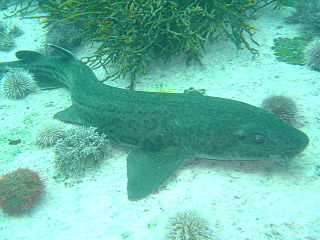
The leopard catshark is a species of catshark, and part of the family Scyliorhinidae, endemic to the coastal waters of South Africa. Abundant in inshore waters under 20 m (66 ft) deep, this bottom-dweller favors rocky reefs, kelp beds, and sandy flats. Growing to a length of 84 cm (33 in), the leopard catshark has a stout body with two dorsal fins placed well back, and a short head and tail. It is extremely variable in color and pattern, with individuals ranging from almost white to black and covered by diverse patterns of black spots, blotches, rosettes, and/or lines. The color pattern changes with age and some forms seem to be location-specific, suggesting the presence of multiple distinct, local populations. In the past, some of the more distinct color forms have been described as different species.
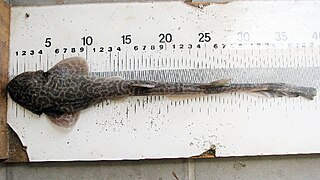
The Izak catshark or simply Izak is a species of shark belonging to the family Pentanchidae, the deepwater catsharks. This species is common off the coasts of South Africa and southern Namibia. It typically inhabits the outer continental shelf at depths of 100–300 m (330–980 ft), with the males found deeper than the females and juveniles. The Izak catshark has a short, wide, flattened head and a robust body tapering to a long, slender tail. It can be identified by its ornate color pattern of dark brown spots or reticulations and blotches on a light yellowish background, as well as by the enlarged dermal denticles over its pectoral fins and along its dorsal midline from the snout to the second dorsal fin. This species reaches 69 cm (27 in) in length, with the males larger than females.
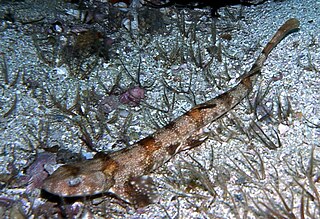
Haploblepharus is a genus of deepwater catsharks, belonging to the family Pentanchidae, containing four species of shysharks. Their common name comes from a distinctive defensive behavior in which the shark curls into a circle and covers its eyes with its tail. The genus is endemic to southern Africa, inhabiting shallow coastal waters. All four species are small, stout-bodied sharks with broad, flattened heads and rounded snouts. They are characterized by very large nostrils with enlarged, triangular flaps of skin that reach the mouth, and deep grooves between the nostrils and the mouth. Shysharks are bottom-dwelling predators of bony fishes and invertebrates. They are oviparous, with the females laying egg capsules. These harmless sharks are of no commercial or recreational interest, though their highly limited distributions in heavily fished South African waters are of potential conservation concern.

The puffadder shyshark, also known as the Happy Eddie, is a species of shark belonging to the family Pentanchidae, the deepwater catsharks. This species is endemic to the temperate waters off the coast of South Africa. This common shark is found on or near the bottom in sandy or rocky habitats, from the intertidal zone to a depth of 130 m (430 ft). Typically reaching 60 cm (24 in) in length, the puffadder shyshark has a slender, flattened body and head. It is strikingly patterned with a series of dark-edged, bright orange "saddles" and numerous small white spots over its back. The Natal shyshark, formally described in 2006, was once considered to be an alternate form of the puffadder shyshark.

The brown shyshark or plain happy is a species of shark belonging to the family Pentanchidae, the deepwater catsharks. It is endemic to the shallow, coastal waters of South Africa from west of Cape Agulhas to KwaZulu-Natal. This benthic species is usually found over sandy or rocky bottoms. Measuring up to 73 cm (29 in) long, the brown shyshark is stoutly built, with a broad, flattened head and rounded snout. Unlike other shysharks, the brown shyshark has a plain brown color, though some individuals have faint "saddle" markings or light or dark spots. When threatened, this shark curls into a circle with its tail over its eyes, which is the origin of the name "shyshark". It feeds on bony fishes and lobsters, and is oviparous with females laying pairs of egg capsules. The International Union for Conservation of Nature (IUCN) has assessed this harmless species as Vulnerable. It is of no commercial or recreational interest, but its limited distribution makes its entire population vulnerable to increases in fishing pressure or habitat degradation.

The dark shyshark or pretty happy is a species of shark belonging to the family Pentanchidae, the deepwater catsharks. This species is endemic to the temperate waters off southern Namibia and western South Africa. It is benthic in nature and inhabits shallow, inshore waters and favors rocky reefs and kelp forests. Growing to 60 cm (24 in) long, this small, stocky shark has a wide, flattened head with a rounded snout and a large flap of skin extending from before the nostrils to the mouth. Its dorsal coloration is extremely variable and may feature black-edged orange to blackish saddles and/or white spots on a light brown to nearly black background.

The tiger catshark is a species of shark belonging to the family Pentanchidae, the deepwater catsharks. It is found over sandy areas and near reef peripheries off South Africa and perhaps Mozambique, from close to shore to usually no deeper than 100 m (330 ft). Reaching a length of 50 cm (20 in), this small, slim shark has a broad, flattened head with an upturned snout tip. It can additionally be identified by its dorsal colour pattern of ten dark brown saddles on a yellowish brown background.

The southern African frilled shark is a species of shark in the family Chlamydoselachidae, described in 2009. It is found in the deep waters off southern Angola to southern Namibia. This species is difficult to distinguish from the better-known frilled shark, but is smaller at maturity and differs in several proportional measurements including head length and mouth width. It seems to be a specialized predator of smaller sharks, using its flexible jaws and numerous needle-like, recurved teeth to capture and swallow them whole. Reproduction is presumably aplacental viviparous, as with the other member of its family.
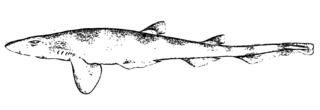
The Antilles catshark is a common but little-known species of deepwater catshark, belonging of the family Pentanchidae. It is found on or near the bottom at a depth of 293–695 m (961–2,280 ft) off Florida and the West Indies from Jamaica to Martinique. It was once regarded as a subspecies of the similar roughtail catshark, along with the longfin sawtail catshark. Growing to 46 cm (18 in) long, the Antilles catshark is a slender species with a marbled color pattern of dark saddles and blotches, as well as a crest of enlarge dermal denticles along the front part of its dorsal caudal fin margin. It feeds on shrimp and may have schooling habits. Reproduction is oviparous.

The Atlantic sawtail catshark is a little-known species of deepwater catshark, belonging to the family Pentanchidae, found in a small area of the northeastern Atlantic Ocean, centered on the Strait of Gibraltar and the Alborán Sea. It is found on or close to the bottom over the continental slope, mostly at depths of 400–600 m (1,300–2,000 ft). This shark closely resembles, and was once thought to be the same species as, the blackmouth catshark (G. melastomus); both are slender with a series of dark saddles and blotches along the back and tail, and a prominent crest of enlarged dermal denticles along the dorsal edge of the caudal fin. It differs subtly from G. melastomus in characters including snout length, caudal peduncle depth, and the color of the furrows at the corner of its mouth.
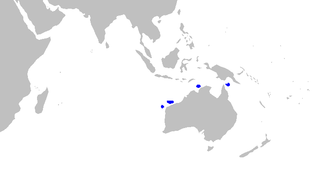
The slender sawtail catshark is a little-known species of deepwater catshark, part of the family Pentanchidae, endemic to northern Australia. It is found over the continental slope in 290–470 m (950–1,540 ft) on water. Growing to 34 cm (13 in) long, this shark has a slim gray body with four dark saddle markings below the dorsal fins and on the caudal fin, as well as a prominent crest of enlarged dermal denticles along the dorsal edge of the caudal fin. The slender sawtail catshark is not valued by fisheries but is taken as bycatch. The International Union for Conservation of Nature (IUCN) presently lacks enough information to assess its conservation status.

The mouse catshark is a species of shark belonging to the family Pentanchidae, the deepwater catsharks. It is common in the northeastern Atlantic Ocean from Iceland to Western Sahara. There is much taxonomic confusion regarding this species in Icelandic waters, where it may be confounded with another species of Galeus or Apristurus. Probably not exceeding 49 cm (19 in) long, the mouse catshark has a uniformly brown body and is characterized by large, rounded pelvic fins and crests of enlarged dermal denticles along both the dorsal and ventral caudal fin margins. In addition, in adult males the inner margins of the pelvic fins are merged into an "apron".

The broadfin sawtail catshark is a species of shark belonging to the family Pentanchidae, the deepwater catsharks. It is found on or near the bottom at depths of 150–540 m (490–1,770 ft), from southeastern Japan to the East China Sea. A slender species growing to 68 cm (27 in) long, this shark is characterized by a fairly long, pointed snout, a series of indistinct, dark saddles along its back and tail, and a prominent crest of enlarged dermal denticles along the dorsal edge of its caudal fin. In addition, adult males have very long claspers that reach past the anal fin. The broadfin sawtail catshark is an opportunistic predator of bony fishes, cephalopods, and crustaceans, with immature and mature sharks being primarily piscivorous. It is oviparous and reproduces year-round.
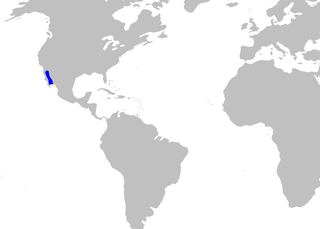
The peppered catshark is a common but little-known species of shark belonging to the family Pentanchidae, the deepwater catsharks. This species inhabits depths of 130–1,326 m (427–4,350 ft) in the northern Gulf of California. It is found on or near the ocean floor, and conducts seasonal migrations, spending winter in deeper water. Reaching a length of 37 cm (15 in), this species has a slender grayish body with a fine covering of black dots. On the dorsal edge of its caudal fin is a prominent crest of enlarged dermal denticles. It is oviparous, with the reproductive period probably lasting from May to September. The International Union for Conservation of Nature (IUCN) has listed the peppered catshark under Least Concern, as it faces no significant threats from human activity.

The African sawtail catshark is a species of shark belonging to the family Pentanchidae, the deepwater catsharks. Demersal in nature, it is found at depths of 160–720 m (520–2,360 ft) off the western African coast from Morocco to South Africa. This slender species has a rather long, pointed snout, a series of dark saddles along the back and tail, and a prominent crest of enlarged dermal denticles along the upper edge of the caudal fin. Its maximum known length is 46 cm (18 in).

The blacktip sawtail catshark is a species of shark belonging to the family Pentanchidae, the deepwater catsharks, This species is found off the coasts of Taiwan and the Philippines. It is demersal in nature and occurs deeper than 60 m (200 ft). Growing up to 46 cm (18 in) long, this slim-bodied species is characterized by its plain brownish dorsal coloration with dark tips on the dorsal and caudal fins, and a prominent crest of enlarged dermal denticles on the upper edge of the caudal fin. It is oviparous, with females producing encapsulated eggs two at a time year-round. The blacktip sawtail catshark is caught incidentally in bottom trawls and used for fishmeal in Taiwan.

The dwarf sawtail catshark is a species of shark belonging to the family Pentanchidae, the deepwater catsharks. This shark is found exclusively in the deep waters off Luzon in the Philippines. Unlike other members of its genus, this slender, diminutive shark has a short, rounded snout and very short furrows at the corners of its jaws. It has indistinct darker saddles beneath each dorsal fin and two dark bands on the caudal fin, as well as a prominent crest of enlarged dermal denticles along the upper caudal fin margin.




















